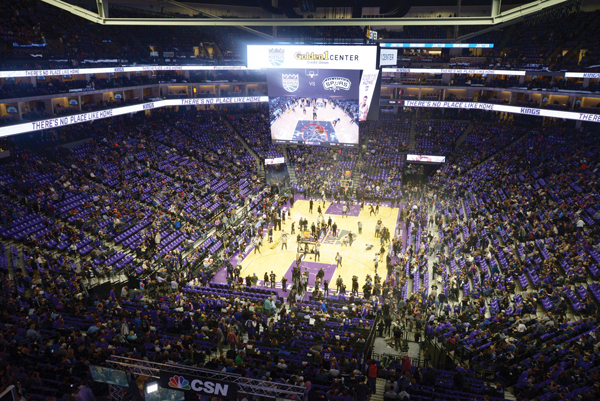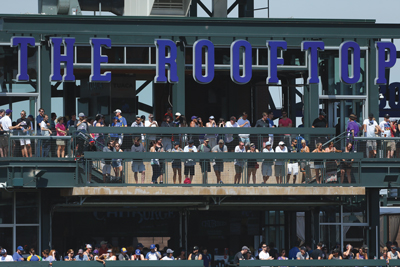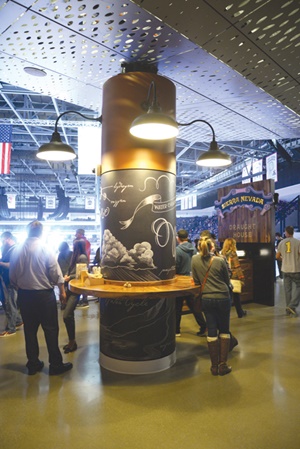 |
Golden 1 Center has the NBA’s largest seating bowl but is built on one of the smallest sites.
Photo by: DENNIS MCCOY / SACRAMENTO BUSINESS JOURNAL
|
Welcome to the era of smart and social sports facilities.
After years of building out massive infrastructure, trends now point to greater flexibility and smaller venues. Facility owners are removing seats in the areas producing the least amount of revenue and replacing them with space for fans to graze, mingle and socialize.
It’s happening in new buildings such as Golden 1 Center and SunTrust Park, and in renovations proposed for 1990s-era facilities Amalie Arena and Philips Arena, which are designing areas to meet the needs of millennials more interested in hanging out than sitting to watch the game.
But it’s not all about downsizing. It’s being smarter at producing more revenue in a venue’s optimal spaces, especially the lower bowl, thanks to analytics tools that allow for more customized and sophisticated packaging.
Add it all up, and the days of bigger is better may be over for sports venues.
“We’ve got renovations today on arenas that seat over 19,000 and our clients are trying to get down to 17,000,” said Tim Romani, founder and CEO of Icon Venue Group. “Overall, there is a move to downsize capacity. It’s happening up top, but not in the lower bowl or in the P1 [top-tier] premium areas, because 70 to 80 percent of the ticket revenue still comes from the first 15 to 20 rows. There’s a real focus on making sure that those counts are right.”
To that end, new NBA arenas in Sacramento, which opened this year, and Milwaukee and San Francisco, both opening over the next three years, have 40 or fewer traditional suites. Those numbers are considerably less than other big league arenas opening over the past 15 years as teams fill the gap with an ample mix of premium products for smaller groups of people.
The key is to create demand and reduce wasted space. Golden 1 Center, for example, has one of the smallest footprints in the NBA, but the Icon-managed project features the league’s largest lower bowl with 10,000 seats, which speaks to the percentages cited by Romani.
A number of factors are driving the smarter use of space, but two most cited are the desire to create sustainable demand for tickets and avoid the spate of empty seats seen at some facilities built in the last 15 years, such as Yankee Stadium and Petco Park. Older ballparks such as Progressive Field, Coors Field and Guaranteed Rate Field have all eliminated thousands of seats after opening in the 1990s. Designers also are learning from other forms of entertainment, such as the movie theater industry and Topgolf, in how venues can compete with the in-home viewing experience.
Smaller, smarter
In baseball, SunTrust Park opens in March with about 41,500 seats after the Atlanta Braves played 19 years at Turner Field, a post-Olympics retrofit that created one of MLB’s biggest stadiums. It had 49,586 seats, a number that often left thousands of seats unsold for Braves games despite the team’s success in the late 1990s and early 2000s.
In Cobb County, though, despite the drastic seat reduction, a much smaller ballpark has a variety of seating products greater than just about any other MLB facility, said Earl Santee, a senior principal at Populous.
“The idea is to create demand and more diversity in premium and normal offerings,” Santee said. “We have three different seating companies working there. It’s going to be unique. Every seating area is specifically designed for the market, with the price points and food and beverage.”
The Oakland A’s are going even smaller, with plans to build a 35,000-seat ballpark, said team President Dave Kaval, the fewest seats in MLB in one of its smallest markets. Kaval holds the same title for the San Jose Earthquakes and was principally involved in developing Avaya Stadium, which at 16,500 fixed seats is one of MLS’s smallest venues. In San Jose, the standing-room supporters section and popular scoreboard bar bookending the stadium provide space for 1,500 additional patrons. The A’s will use those same flexible concepts for developing their new ballpark in the coming years, Kaval said.
“Standing terraces where people can gather are nice for groups of millennials,” he said. “They’re not just stuck in a seat for nine innings. We’re going to lean on the soccer experience. Sports venues need to be smart.”
In South Florida, the $500 million makeover of Hard Rock Stadium has subtracted 10,000 seats from when it first opened in 1987, but on the flip side, there are many more seating options compared with its old model of general seating, suites and club seats. (See story).
There are exceptions to the downsizing trend, such as the new NHL arenas in Detroit and Edmonton, built in cities starved for new hockey venues, said George Heinlein, HOK’s senior vice president and regional leader. Detroit’s Little Caesars Arena has 19,600 seats, just 400 fewer than the building it will replace, Joe Louis Arena.
“If you look at what we’re doing in Detroit, that seating capacity is a lot healthier than most new arenas,” Heinlein said. “But you shouldn’t design a building based on having a winning team every year. Teams are going to have their ups and downs. You’ve got to design it to survive in all years.”
‘You’re in a different place’
As part of the trend, architects are brainstorming ways to reinvent the upper deck. Those seats are the most costly to build because of the elevated structure and support systems required for construction at the building’s highest level. And because they’re the furthest from the action, those seats are typically the last to sell and produce the least revenue. As a result, designers are searching for new and creative ways to break up the upper bowl but still keep those spaces profitable and provide an option for cost-conscious fans and families occupying those seats.
In many cases, the younger generation and how it consumes a sports event is driving the need for change and a reduction of upper-deck seats. For those in their 20s and 30s, the focus is on having a shared experience at a live event instead of the game itself being the center of attention.
 |
The Rooftop at Coors Field opened in 2014 as a general admission, standing room area and bar.
Photo by: GETTY IMAGES
|
Coors Field’s The Rooftop deck, Progressive Field’s The Corner Bar, SunTrust Park’s Xfinity Lounge and Rooftop and Mystic Lake’s Club Purple at U.S. Bank Stadium are four examples of creative social spaces in the upper deck in lieu of regular seats.
“It’s obvious that the capacity of these venues are reducing because they’re not interested in the in-seat experience as much anymore,” said Jim Renne, a sports principal with Rossetti. “We’re looking closely at the migration from in-seat to in-venue experiences, so it’s an entire experience.”
In Canada, Rossetti is working for the Calgary Flames and the Ottawa Senators on new arena developments. For both projects, the architect is exploring some innovative ideas for how to reshape the upper deck to fit the changing tastes of today’s younger fans.
To this point, financing has not been approved for both projects, and no decisions have been made for what the upper bowls could look like in the two Canadian buildings. But the ideas continue to flow on the concept, Renne said.
“There are things we’re looking at right now, such as the disappearance of the upper bowl,” he said. “It doesn’t mean that we’re talking about a single bowl, but the nature of how you watch sports is different, and therefore, the upper bowl seats need to become a different experience altogether, where it’s more about social engagement, community and not being in your seat.”
Social spaces hovering over the ice such as Madison Square Garden’s bridge seats and Little Caesars Arena’s gondolas, modeled after the old Olympia in Detroit, are two examples of “how you might be close to a sport but you’re not really watching it much,” Renne said. “You’re in a different place.”
Topgolf’s concept of placing groups of six to eight people in furnished spaces similar to an open-air suite, all stacked among three levels, is an idea HOK is using as inspiration for creating new social destinations in Philips Arena’s upper deck, Heinlein said.
“You’ve got your own space but are in communion with the rest of the groups right next to you,” he said.
Right-sizing the venue
The concept of a shrinking upper deck can be difficult to grasp because the traditional seating bowl has been in place for decades, but Renne said team owners have shown keen interest in the concept. The potential also exists to cut construction costs with less structural foundation required, he said.
Sports designer David Manica has long been a proponent of smaller, more efficient buildings, and he sees a parallel to changes made in the movie theater industry. The big chains aren’t building giant theaters anymore. Instead, they’re producing smaller ones within a larger complex equipped with more comfortable seats and a higher level of service. It’s all part of competing against the home theater experience, “something our industry is fighting as well,” Manica said.
 |
Madison Square Garden’s bridge seats allow fans to be close to the game even if they are not watching closely.
Photo by: PATRICK E. MCCARTHY
|
Manica, the architect for Chase Center, the Golden State Warriors’ arena opening in 2019, did some initial design work for a joint-use stadium for the San Diego Chargers and Oakland Raiders proposed in Carson, Calif. The project is now dead after NFL owners approved Inglewood as the preferred site in Greater Los Angeles, but Manica said both teams had agreed to develop a 65,000-seat building expandable to 75,000 for Super Bowl.
“They were willing to sacrifice capacity to ‘right-size’ the building for the market and make sure they’re not building more seats than they can sell, understanding that those last 5,000 seats you build are the worst in the house and the most expensive to construct,” he said.
In Inglewood, the one NFL stadium project moving ahead in Southern California will have 72,000 fixed seats and the ability to grow to 100,000 for the Super Bowl and Olympics through temporary seating and standing-room-only spaces in the corners and end zones and along the sidelines, all with views to the field.
The setup for the Los Angeles Rams’ palace will be similar to AT&T Stadium in Arlington, Texas, home of the Dallas Cowboys. HKS designed the Cowboys’ facility and is doing the same for the Rams’ $2.6 billion stadium.
“Every year, owners are getting more sophisticated in understanding the business side of these buildings,” said Mark Williams, a principal with HKS and its director of business development. “The result of that is those ‘magic numbers’ of the past are going to start to trickle away and [seating capacity] is going to be based on true regional demographics. For many years, I’ve scratched my head over why a hockey venue in New York should be the same size as a hockey venue in Columbus, Ohio. It’s hard to understand.”
The danger for teams, though, is phasing out the family-affordable seats situated in the upper deck. In addition, the individual leagues have seating requirements for regular-season games and all-star events, and concert promoters push for greater seat counts as well, architects said.
 |
The Sierra Nevada Draught House is a popular gathering spot in the arena’s upper deck.
Photo by: DENNIS MCCOY / SACRAMENTO BUSINESS JOURNAL
|
The NBA, for example, has strict standards for capacity which it keeps confidential, and those standards can be difficult for teams and developers to negotiate, said Jon Niemuth, AECOM’s director of sports in the Americas.
“But [the issue is] how do we make those buildings efficient from a functional standpoint but get all the revenue-generating things they need to make it viable,” he said.
For AECOM, working on a potential $150 million renovation of Amalie Arena, its talks with the Tampa Bay Lightning are tied to coming up with some new SRO spaces with enough flexibility to accommodate anywhere from 200 to 2,000 people depending on the day of the week.
It’s similar in scope to what’s already in place at AECOM-designed Golden 1 Center. The Sierra Nevada Draught House, a large standing-room space in the upper deck, has proved to be among the hottest bars in Sacramento. It’s the idea of blending a general-admission area into the seating bowl that makes the building appear full regardless of the total number of fans mingling in the space, Niemuth said.
“Spaces like that, there’s some potential for how we exactly think about it, talk about it and measure it … all part of the capacity that give you the opportunity to have a full house,” he said. “It’s a topic we’re going to be pretty aggressively invested in for the next few years.”







